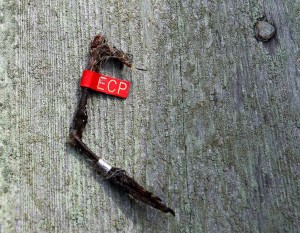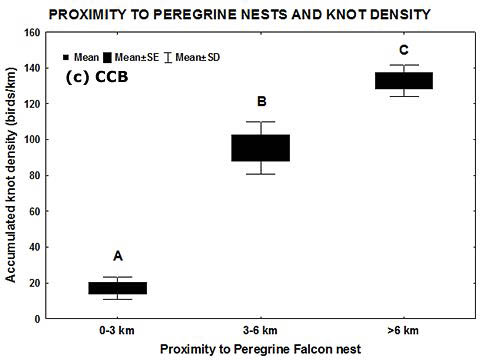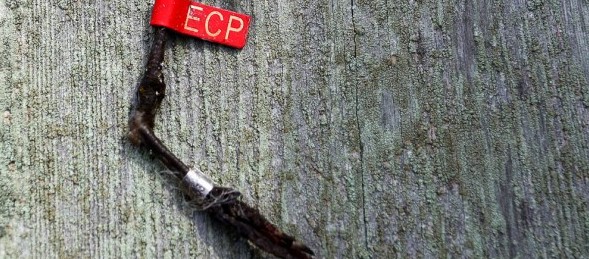Conservation in conflict: peregrines vs red knots
Azalea relocates a few miles south
August 31, 2009Eagle economics & the social burden of conservation success
September 2, 2009
Written by Bryan Watts
September 1, 2009

A red knot band recovered from peregrine falcon tower on Cobb Island – this bird was banded on the wintering grounds in Chile. Photo by Bryan Watts.
It can be particularly challenging to manage predators and their primary prey within the same geographic location when both are of high conservation concern. Since the late 1970s, strategies to recover the peregrine falcon population in eastern North America have included encouraging birds to nest on artificial structures on the outer fringe of the mid-Atlantic Coastal Plain. This same area plays a particularly significant role in the life cycle of several waterbirds that represent dominant prey items for peregrines and are of high conservation concern. This potential conflict has been the focus of considerable concern over the past several years as the population of peregrines has increased and the population of some waterbird species has become critical.
Since 1978 when the first releases were conducted on Cobb Island, The Center for Conservation Biology (CCB) along with several partners including the Virginia Department of Game & Inland Fisheries (VDGIF), the Peregrine Fund, The Nature Conservancy (TNC), and the U.S. Fish and Wildlife Service (FWS) has worked to establish and manage the peregrine falcon population along the seaside of the Delmarva Peninsula. Since 1994, Bryan Watts from CCB and Barry Truitt from TNC have conducted aerial surveys of the Virginia Barrier Islands for spring-migrating shorebirds. In the fall of 2009, CCB used both of these datasets to investigate the influence of peregrine falcon breeding pairs on the distribution of staging red knots along barrier beaches.

Peregrine falcon brood standing on a bed of shorebird feathers in a nest box on the tower in Gull Marsh, Virginia Barrier Islands. Photo by Bryan Watts.
The density of red knots staging along barrier island beaches was investigated by stratifying shorelines according to their proximity to active falcon nests. Three distance categories were used including close (0-3 km), near (3-6 km) and far (>6 km). Migrant red knots showed a significant response to falcon nests with mean densities varying between 17.0±3.04 birds/km, 95.3±7.31, and 132.9±4.41 for close, near, and far shorelines respectively. In addition, for 5 nesting territories that changed activity status during the study period, knot density was significantly higher close to nests during years when territories were not active compared to when they were.

Influence of active peregrine falcon nests on the distribution of red knots along the Virginia Barrier Islands during spring migration. Graph by the Center for Conservation Biology.
This study has been the first to demonstrate that active peregrine territories are having an impact on the availability of habitat for staging red knots. It is possible that this predator-prey interaction may have a negative impact on the ability of red knots to prepare for their final flight to breeding grounds in the High Arctic. Such impacts should be considered in the management objectives of both peregrines and waterbirds. CCB along with TNC, FWS, and the state have begun to remove peregrine nesting substrates in strategic locations where they are having the greatest impact on waterbird populations.
Project sponsored by The Center for Conservation Biology (CCB), The Nature Conservancy (TNC), US Fish & Wildlife Service (USFWS), and the Virginia Department of Game & Inland Fisheries (VDGIF).




